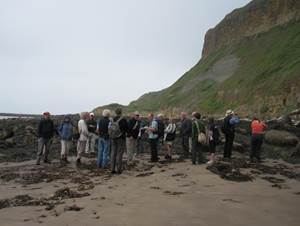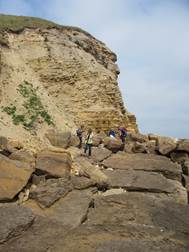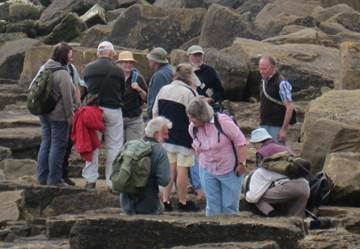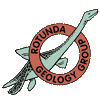On a nice summer morning about 30 members and friends met at the foot of the path down to the middle of Cayton Bay, where Pete Rawson gave a brief overview of the geology. The Middle and Upper Jurassic rocks exposed here accumulated in the Peak Trough, very close to the eastern margin which is represented by the Red Cliff fault. The fault is marked by a deep gulley just to the SE of the bay immediately beyond High Red Cliff. The whole of the Cayton Bay area is affected by faults associated with movement within the trough. The solid rocks are exposed towards the headlands at either end of the bay, while glacial tills cap the Jurassic sediments and come down to below sea level in the middle part of the bay. In geologically recent times there have been numerous landslips associated with the tills, of which that at Knipe Point is just the latest example.
We then walked northwards to a cliff face and fallen boulders beneath, just beyond the pumping station. The rocks here at Tenants’ Cliff form part of the Lower Calcareous Grit Formation and consist of calcareous sandstones with numerous hard concretions, some the size and shape of a large ball, hence the informal name “ball beds”. These have long been famous to fossil collectors – although at least 90% of the concretions are unfossiliferous, a small minority are richly packed with small ammonites and bivalves. Unfortunately they have suffered accordingly from fossil collecting and we found very few, though the common trace fossils, especially crustacean burrows, proved interesting.
From here we walked across the beach to Osgodby Point at the NE corner of the bay. Faults cross the cliff and shore here and we caught glimpses of the Osgodby Formation before reaching Middle Jurassic sediments of the Cloughton Formation that form beautifully cross-bedded sandstones in the cliff face. But the shore here is crossed by a scar formed by the Millepore Bed, which consists of a few courses of massively-bedded sandy, bioclastic limestone divided into big sub-rectangular blocks by a series of vertical joints. Here some of our more enthusiastic members soon got down on hands and knees to find the bryozoans (“millepores” ) that Paul Taylor had talked to us about two months earlier. Also striking were the small star-shaped crinoids ossicles scattered through the sediment.
We then walked back across the bay to the SE end, to the impressive High Red Cliff - formed by the Osgodby, Oxford Clay and Lower Calcareous Grit formations, with the silty Oxford Clay forming the steep slopes in the middle part of the cliff and the Lower Calcareous Grit the higher vertical slopes. Only the Osgodby Formation, forming the lowest part of the cliff, is accessible though fallen blocks from the higher beds litter the shore and again the most striking feature was the abundance of crustacean burrows (Thallassinoides) in the grit blocks. The Osgodby Formation was seen to be a yellowish clean sandstone at most levels, but iron-stained at others, the latter layers containing small ooliths of iron carbonate. The overlying Oxford Clay Formation is “striped” by distinctive pale/dark couplets on a Milankovitch scale. After a hunt for fossils in the fallen blocks the party gave a vote of thanks to the leader before returning home.



